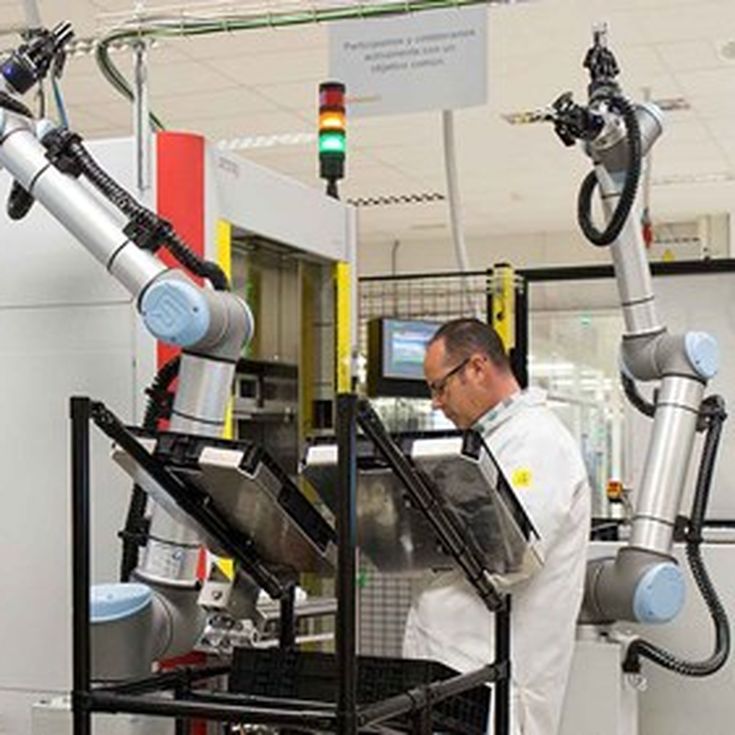

UR10 helps reduce changeovers by 50%
In short
The multinational company Continental is a good example of the transition taking place in the industry; as a leading company in the automotive sector, Continental is by far the most robotized Spanish manufacturer in the business and the first to pioneer the move towards industry 4.0. In 2016, the company decided to acquire several UR10 cobots to automate the manufacture and handling of PCB boards, bringing down changeover times by 50%, from 40 to 20 minutes when compared to performing the task manually.
The business transformation
Continental is a constantly growing company which, during its 25 years of history in the automotive industry, has always focused on innovation and as a result, has won numerous major projects in the face of competition from other top level players.
Cyril Hogard, plant manager at Continental Automotive Spain, emphasizes that one of the main challenges of the industry is to improve productivity given that the company operates within a very competitive sector. When he first heard about collaborative robots 2 years ago he was quickly convinced that the cobots would be a cornerstone for the growth of Continental Automotive within Industry 4.0, based among other things on fast and easy integration, minimal maintenance and improved productivity.
Continental
The solution
The company Continental Automotive Spain chose Universal Robots to perform the tasks of handling and validating PCB boards and components during their manufacturing process, a monotonous and repetitive task which at the same time requires precision and delicacy.
Initially they installed two UR10 robots for loading and unloading PCB boards and for assembly of components. Currently six UR10 cobots are installed with three additional UR10 projects underway.
The first project was initiated with special enthusiasm as the use of collaborative robots meant working with a groundbreaking technology with processes based on a more modern robotic philosophy, in accordance with the new Industry 4.0, heralding the emergence of the Smart Factory where automation and the Industrial Internet of Things (IIOT) are key.
The UR robot application was accomplished by the engineer Víctor Cantón, who accepted the challenge despite having no experience in robotics up until then. However, within a few weeks he understood the basics of the UR cobots and was able to start the programming. Having a UR available at a very early stage of the project allowed him to carry out tests and calculations of the cycle and movements in a laboratory in order to streamline and accelerate the implementation.


Cyril Hogard, Plant managerI immediately saw the advantages of collaborative robots. Easy integration, zero maintenance and higher productivity
The benefits of implementation
The Continental team is very pleased with the results of the implementation of the UR cobots on their production line
Control and flexibility
The company managed to keep control over the decisions made by the robot thanks to very simple programming; all the electronics and robot controllers are combined within a central point, allowing them to make programming changes without the help of outside experts.
Less burden for the team
The cobot arrival meant a change in the role of operators who no longer have to perform menial tasks such as moving components from one station to the next. They can now concentrate on skilled tasks that contribute to improving production.
Cost reduction
Automating the work of moving parts and components around the plant has allowed Continental to reduce operating costs by bringing down changeover times by 50%, from 40 to 20 minutes when compared to performing the task manually.
Security
The team at Continental is very satisfied with the security measures associated with collaborative robots. For example, the operator can enter the cell at any time and the robot stops instantly due to additional sensors that stop when the operator get close to the robot.
Automation challenges solved
Productivity improvement by bringing down changeovers by 50%, from 40 to 20 minutes. Simple programming and implementation enabled Continental to keep the control of the robot in-house.
Key value drivers
Easy programming Flexibility Collaboration and employee safety
Tasks solved by collaborative robots
Machine tending Pick and place
Get in touch with Universal Robots
Thousands of businesses rely on Collaborative Robots to...
- Increase productivity
- Adapt to changing product demand
- Improve employee well-being and retention
- Staff through labor shortages
- Universal Robots USA, Inc
- 27175 Haggerty Road, Suite 160
- 48377 Novi, MI